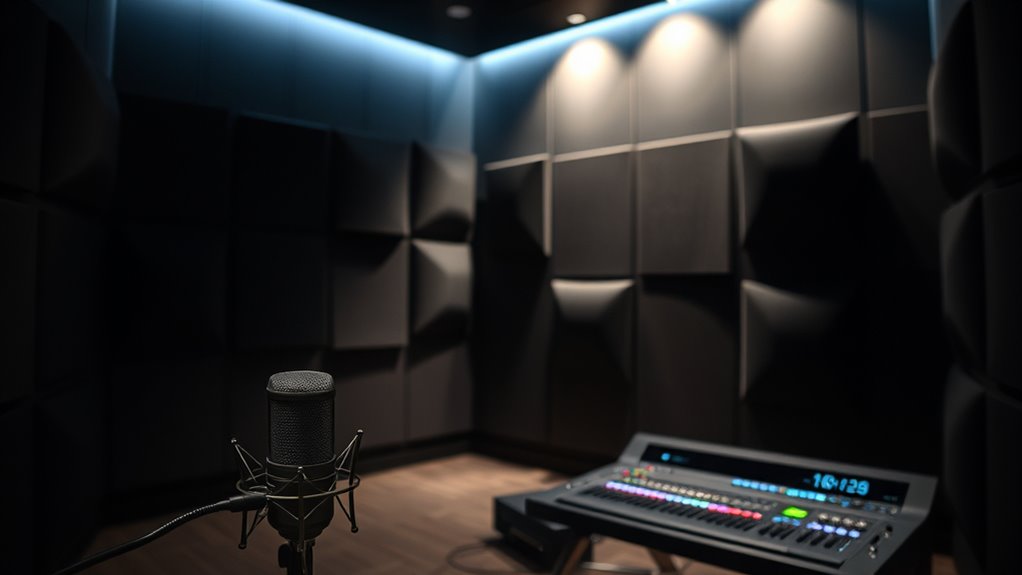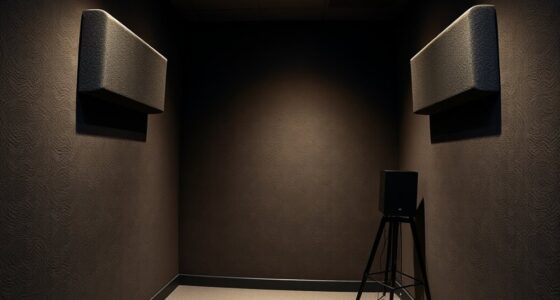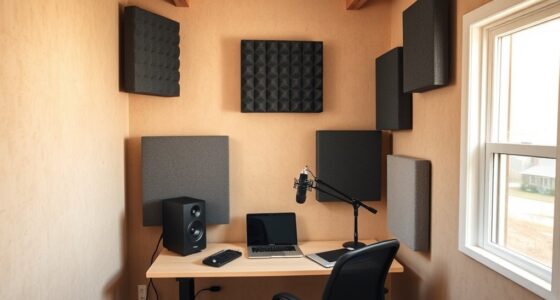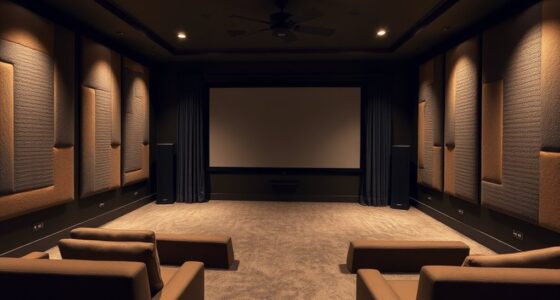Understanding room modes and resonance helps you realize how sound waves interact within your space, causing certain frequencies to boost or cancel out. These standing waves create uneven bass and dead spots, impacting your listening experience. Room dimensions determine which frequencies are affected most, leading to boomy or hollow sounds. By managing reflections and using acoustic treatments, you can improve sound clarity. Keep exploring to discover how to optimize your space for the best possible audio.
Key Takeaways
- Room modes are specific frequencies caused by room dimensions that reinforce or cancel sound waves.
- Resonance occurs when sound waves amplify at certain points, leading to boomy or hollow bass.
- Standing waves create uneven sound distribution, affecting clarity and critical listening accuracy.
- Acoustic treatments like bass traps and diffusers help reduce resonances and smooth out frequency response.
- Understanding sound wave behavior and room design allows for better placement of treatments and improved acoustics.
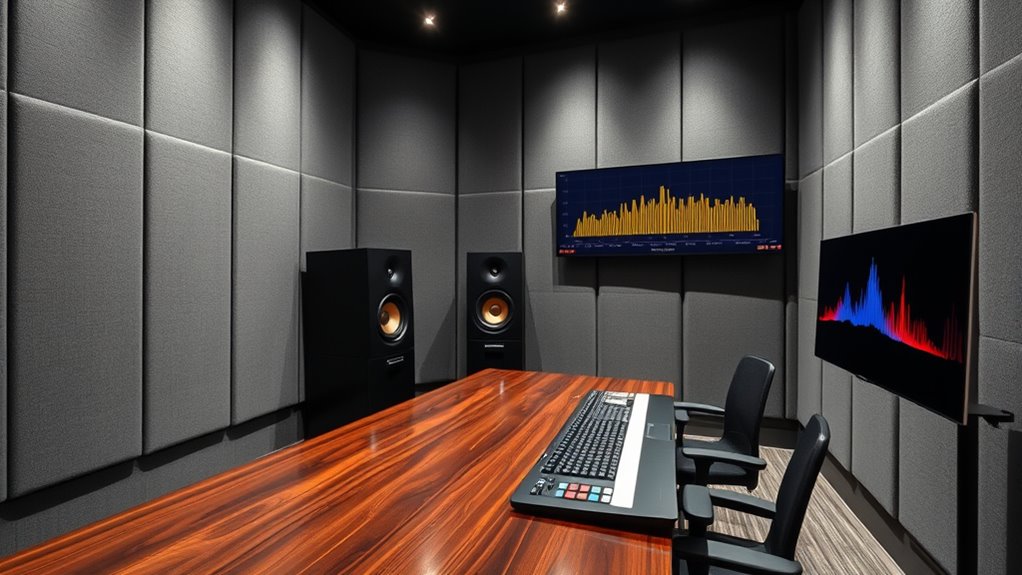
When you listen to music or watch a movie, the way sound behaves in your room can considerably impact your experience. One of the key factors influencing this is how bass frequencies interact with your space. Low-frequency sounds, or bass, tend to create standing waves or room modes, which are specific points where sound waves reinforce or cancel each other out. These modes can cause certain spots in your room to sound boomy or overly muted, disrupting the clarity and balance of your audio. To address this, acoustic treatment becomes essential. Proper acoustic treatment involves strategically placing bass traps and diffusers to absorb or scatter these bass frequencies, helping to smooth out the response and reduce problematic resonances.
Understanding room modes requires recognizing that every room has natural resonant frequencies determined by its dimensions. When sound waves reflect off walls, ceiling, and floors, they can either amplify or diminish certain frequencies at specific locations. This creates uneven sound distribution, with some areas experiencing exaggerated bass while others lack it altogether. As a result, your listening experience can feel inconsistent, making it difficult to accurately judge sound quality, especially in critical listening environments like a home theater or studio. Acoustic treatment addresses these issues by breaking up standing waves, dispersing energy, and minimizing the impact of room modes on your audio. Additionally, understanding the importance of sound wave behavior can help you optimize your room for better sound quality.
You might notice that bass sounds seem disproportionately loud or hollow depending on where you sit in the room. This is often due to room resonance—certain frequencies resonate more due to the room’s dimensions—causing peaks and dips in your audio spectrum. Managing these resonances isn’t just about adding soundproofing or insulation; it’s about carefully controlling how sound interacts within the space itself. Effective acoustic treatment helps create a flatter, more even frequency response, enhancing clarity and detail across all ranges. It’s a proactive step that makes your listening environment more accurate and enjoyable.
Frequently Asked Questions
How Do Room Modes Affect Sound Quality in Small Spaces?
Room modes cause sound wave interactions that can lead to uneven sound quality in small spaces. When certain frequencies interfere, they create peaks and dips in your audio, making some sounds too loud or muffled. This resonance distortion affects clarity and balance, especially at specific spots. To improve, you can add bass traps or diffusers, reducing the impact of these modes and ensuring a more accurate, pleasant listening experience.
Can Resonance Be Completely Eliminated From a Room?
Resonance can’t be completely eliminated, but you can tame it like a wild stallion. Through resonance suppression and soundproofing techniques, you’ll soften the room’s natural booms and rumbles, creating a smoother soundscape. Think of it as whispering to a thunderstorm—your efforts can diminish its roar, making the space more pleasant. While total eradication is impossible, strategic adjustments transform chaos into harmony, giving you a more controlled and enjoyable listening experience.
What Are the Best Materials to Reduce Resonance?
You can reduce resonance effectively by using materials like diffusion panels and bass traps. Diffusion panels scatter sound waves, preventing them from bouncing excessively and causing resonance, while bass traps absorb low-frequency energy that often leads to room modes. Combining these materials in strategic locations helps balance your room’s acoustics, making your listening or recording environment clearer. Keep in mind, though, completely eliminating resonance isn’t always possible, but these solutions markedly improve sound quality.
How Do Room Dimensions Influence the Number of Modes?
Room dimensions directly influence the number of modes you experience. Smaller rooms tend to have fewer, more pronounced modes, while larger spaces offer a wider mode distribution, reducing the impact of individual resonances. By adjusting your room’s length, width, and height, you can modify the mode distribution, minimizing problematic resonances. Careful planning of room dimensions helps create a balanced sound environment, improving overall acoustic clarity.
Are There Specific Acoustic Treatments for Problematic Modes?
Yes, you can use specific acoustic treatments like bass trapping to address problematic modes. Bass traps absorb low-frequency energy, reducing resonance issues, and help smooth out diffraction patterns caused by room dimensions. Strategically placing bass traps in corners or along walls can markedly improve sound clarity. This targeted approach makes your room more balanced, ensuring better sound quality and a more enjoyable listening or recording environment.
Conclusion
Now that you understand room modes and resonance, you’re better equipped to optimize your space for better sound. Did you know that standing waves can cause bass frequencies to be up to 10 times louder in certain spots? By addressing these issues, you can enjoy clearer, more balanced audio. Remember, small adjustments can make a big difference—so don’t hesitate to experiment and create the perfect listening environment for your needs.
